Morphology-Dependent Behavior of PVDF/ZnO Composites: Their Fabrication and Application in Pressure Sensors
Abstract
1. Introduction
2. Materials and Methods
2.1. Materials
2.2. Synthesis of ZnO with Controlled Morphologies
2.3. Preparation of PVDF/ZnO Composite Films
2.4. Preparation of PVDF/ZnO-Based Sensors
2.5. Characterizations
3. Results
3.1. Characterization of the Synthesized ZnO Particles
3.2. Characterization and Application of the Piezoelectric Composite Films
4. Discussion
5. Conclusions
Supplementary Materials
Author Contributions
Funding
Institutional Review Board Statement
Informed Consent Statement
Data Availability Statement
Conflicts of Interest
Abbreviations
| DIW | Direct Ink Writing |
| FTIR | Fourier-transform Infrared Spectroscopy |
| PVDF | Polyvinylidene Fluoride |
| SEM | Scanning Electron Microscopy |
| SSA | Specific Surface Area |
| XRD | X-ray diffraction |
References
- Tang, J.; Li, Y.; Yu, Y.; Hu, Q.; Du, W.; Lin, D. Recent Progress in Flexible Piezoelectric Tactile Sensors: Materials, Structures, Fabrication, and Application. Sensors 2025, 25, 964. [Google Scholar] [CrossRef] [PubMed]
- Yang, M.; Huang, W.; Chen, R.; Ma, Z. Flexible Electrospun Nanofibers for Tactile Sensing and Integrated System Research. IEEE Sens. J. 2025, 25, 9–16. [Google Scholar] [CrossRef]
- Li, M.; Zang, H.; Long, J.; Sun, S.; Zhang, Y. Flexible Pressure Sensors Based on Polyvinylidene Fluoride: A Critical Review. Materials 2025, 18, 615. [Google Scholar] [CrossRef] [PubMed]
- Alotaibi, A. Flexible 3D Force Sensor Based on Polymer Nanocomposite for Soft Robotics and Medical Applications. Sensors 2024, 24, 1859. [Google Scholar] [CrossRef]
- Kumaki, D.; Motoshima, Y.; Higuchi, F.; Sato, K.; Sekine, T.; Tokito, S. Unobstructive Heartbeat Monitoring of Sleeping Infants and Young Children Using Sheet-Type PVDF Sensors. Sensors 2023, 23, 9252. [Google Scholar] [CrossRef]
- Dallaev, R.; Pisarenko, T.; Sobola, D.; Orudzhev, F.; Ramazanov, S.; Trčka, T. Brief Review of PVDF Properties and Applications Potential. Polymers 2022, 14, 4793. [Google Scholar] [CrossRef]
- Cai, X.; Lei, T.; Sun, D.; Lin, L. A critical analysis of the α, β and γ phases in poly(vinylidene fluoride) using FTIR. RSC Adv. 2017, 7, 15382–15389. [Google Scholar] [CrossRef]
- Wei, T.; Dong, B.; Hu, Y.; He, S.; Wang, Y.; Lin, P.; Huang, W. A Flexible Film Bulk Acoustic Resonator Radio-Frequency Sensor Based on β-Type PVDF Films for Tactile Perception. ACS Appl. Electron. Mater. 2024, 6, 8870–8878. [Google Scholar] [CrossRef]
- Zhang, C. Large-Scale Fabrication of High β-Phase PVDF Films with Enhanced Piezoelectric and Electrode Formation Properties. J. Mater. Eng. Perform. 2024, 1–14. [Google Scholar] [CrossRef]
- Mireja, S.; Khakhar, D.V. High β-phase PVDF films formed by uniaxial compression. Polymer 2024, 293, 126665. [Google Scholar] [CrossRef]
- Kalimuldina, G.; Turdakyn, N.; Abay, I.; Medeubayev, A.; Nurpeissova, A.; Adair, D.; Bakenov, Z. A Review of Piezoelectric PVDF Film by Electrospinning and Its Applications. Sensors 2020, 20, 5214. [Google Scholar] [CrossRef] [PubMed]
- Yang, Y.; Pan, H.; Xie, G.; Jiang, Y.; Chen, C.; Su, Y.; Wang, Y.; Tai, H. Flexible piezoelectric pressure sensor based on polydopamine-modified BaTiO3/PVDF composite film for human motion monitoring. Sens. Actuators A Phys. 2020, 301, 111789. [Google Scholar] [CrossRef]
- Chen, C.; Zhang, R.; Zhu, J.; Qian, X.; Zhu, J.; Ye, X.; Zhang, M. Direct writing polyvinylidene difluoride thin films by intercalation of nano-ZnO. Polym. Eng. Sci. 2021, 61, 1802–1809. [Google Scholar] [CrossRef]
- Xu, T.; Jin, L.; Ao, Y.; Zhang, J.; Sun, Y.; Wang, S.; Qu, Y.; Huang, L.; Yang, T.; Deng, W.; et al. All-polymer piezo-ionic-electric electronics. Nat. Commun. 2024, 15, 10876. [Google Scholar] [CrossRef]
- Kong, H.Y.; Jin, Y.; Li, G.Y.; Zhang, M.H.; Du, J.K. Design and Fabrication of a Hierarchical Structured Pressure Sensor Based on BaTiO3/PVDF Nanofibers via Near-Field Electrospinning. Adv. Eng. Mater. 2023, 25, 2201660. [Google Scholar] [CrossRef]
- Mei, Y.; Cao, C.; Zhou, P.; Wang, J.; Liu, M.; Shang, X.; Jiang, J.; Qi, Y.; Zhang, T. Flexible Pressure Sensors Based on P(VDF-TrFE) Films Incorporated with Ag@PDA@PZT Particles. Sensors 2024, 24, 5415. [Google Scholar] [CrossRef]
- Yang, T.; Pan, H.; Tian, G.; Zhang, B.; Xiong, D.; Gao, Y.; Yan, C.; Chu, X.; Chen, N.; Zhong, S.; et al. Hierarchically structured PVDF/ZnO core-shell nanofibers for self-powered physiological monitoring electronics. Nano Energy 2020, 72, 104706. [Google Scholar] [CrossRef]
- Tian, G.; Deng, W.; Gao, Y.; Xiong, D.; Yan, C.; He, X.; Yang, T.; Jin, L.; Chu, X.; Zhang, H.; et al. Rich lamellar crystal baklava-structured PZT/PVDF piezoelectric sensor toward individual table tennis training. Nano Energy 2019, 59, 574–581. [Google Scholar] [CrossRef]
- Chang, G.; Pan, X.; Hao, Y.; Du, W.; Wang, S.; Zhou, Y.; Yang, J.; He, Y. PVDF/ZnO piezoelectric nanofibers designed for monitoring of internal micro-pressure. RSC Adv. 2024, 14, 11775–11783. [Google Scholar] [CrossRef]
- Han, J.; Li, D.; Zhao, C.; Wang, X.; Li, J.; Wu, X. Highly Sensitive Impact Sensor Based on PVDF-TrFE/Nano-ZnO Composite Thin Film. Sensors 2019, 19, 830. [Google Scholar] [CrossRef]
- Arjun Hari, M.; Karumuthil, S.C.; Rajan, L. Optimization of PVDF nanocomposite based flexible piezoelectric tactile sensors: A comparative investigation. Sens. Actuators A Phys. 2023, 353, 114215. [Google Scholar]
- Minakshi, P.; Mohan, H.; Manjeet; Ravina; Brar, B.; Shafiq, M.; Pundir, C.S. Organic Polymer and Metal Nano-particle Based Composites for Improvement of the Analytical Performance of Electrochemical Biosensors. Curr. Top. Med. Chem. 2020, 20, 1029–1041. [Google Scholar] [CrossRef] [PubMed]
- Kausar, A. Polymeric materials filled with hematite nanoparticle: Current state and prospective application. Polym.-Plast. Technol. Mater. 2020, 59, 323–338. [Google Scholar] [CrossRef]
- Fraleoni-Morgera, A.; Cesini, I.; Kumar, P.; Oddo, C.M. Hydrothermally Grown ZnO Nanorods as Promising Materials for Low Cost Electronic Skin. ChemNanoMat 2020, 6, 15–31. [Google Scholar] [CrossRef]
- Abdullah, I.Y.; Yahaya, M.; Jumali, M.H.H.; Shanshool, H.M. Effect of annealing process on the phase formation in poly(vinylidene fluoride) thin films. AIP Conf. Proc. 2014, 1614, 147–151. [Google Scholar]
- Mahapatra, A.; Ajimsha, R.S.; Ittoop, M.O.; Sharma, A.; Karmakar, S.; Shaikh, A.; Sankar, P.R.; Misra, P. Flexible ZnO:PVDF based free standing piezoelectric nanogenerator for vibrational energy harvesting and wearable shoe insole pedometer sensor. J. Alloys Compd. 2023, 960, 170898. [Google Scholar] [CrossRef]
- Dutta, B.; Kar, E.; Bose, N.; Mukherjee, S. Significant enhancement of the electroactive β-phase of PVDF by incorporating hydrothermally synthesized copper oxide nanoparticles. RSC Adv. 2015, 5, 105422–105434. [Google Scholar] [CrossRef]
- Pratihar, S.; Medda, S.K.; Sen, S.; Devi, P.S. Tailored piezoelectric performance of self-polarized PVDF-ZnO composites by optimization of aspect ratio of ZnO nanorods. Polym. Compos. 2020, 41, 3351–3363. [Google Scholar] [CrossRef]
- Yang, H.; Zhao, L.-z.; Zhang, Y.; Luo, H.; Wang, R.-c.; Zhang, D.; Wang, X.-f. Electrical properties of PVDF films fabricated by direct ink writing. J. Cent. South Univ. 2023, 30, 1477–1489. [Google Scholar] [CrossRef]
- Chamankar, N.; Khajavi, R.; Yousefi, A.A.; Rashidi, A.; Golestanifard, F. A flexible piezoelectric pressure sensor based on PVDF nanocomposite fibers doped with PZT particles for energy harvesting applications. Ceram. Int. 2020, 46, 19669–19681. [Google Scholar] [CrossRef]
- Wu, C.-M.; Chou, M.-H.; Zeng, W.-Y. Piezoelectric Response of Aligned Electrospun Polyvinylidene Fluoride/Carbon Nanotube Nanofibrous Membranes. Nanomaterials 2018, 8, 420. [Google Scholar] [CrossRef] [PubMed]
- Wei, C.; Zhou, H.; Zheng, B.; Zheng, H.; Shu, Q.; Du, H.; Ma, A.; Liu, H. Fully flexible and mechanically robust tactile sensors containing core–shell structured fibrous piezoelectric mat as sensitive layer. Chem. Eng. J. 2023, 476, 146654. [Google Scholar] [CrossRef]
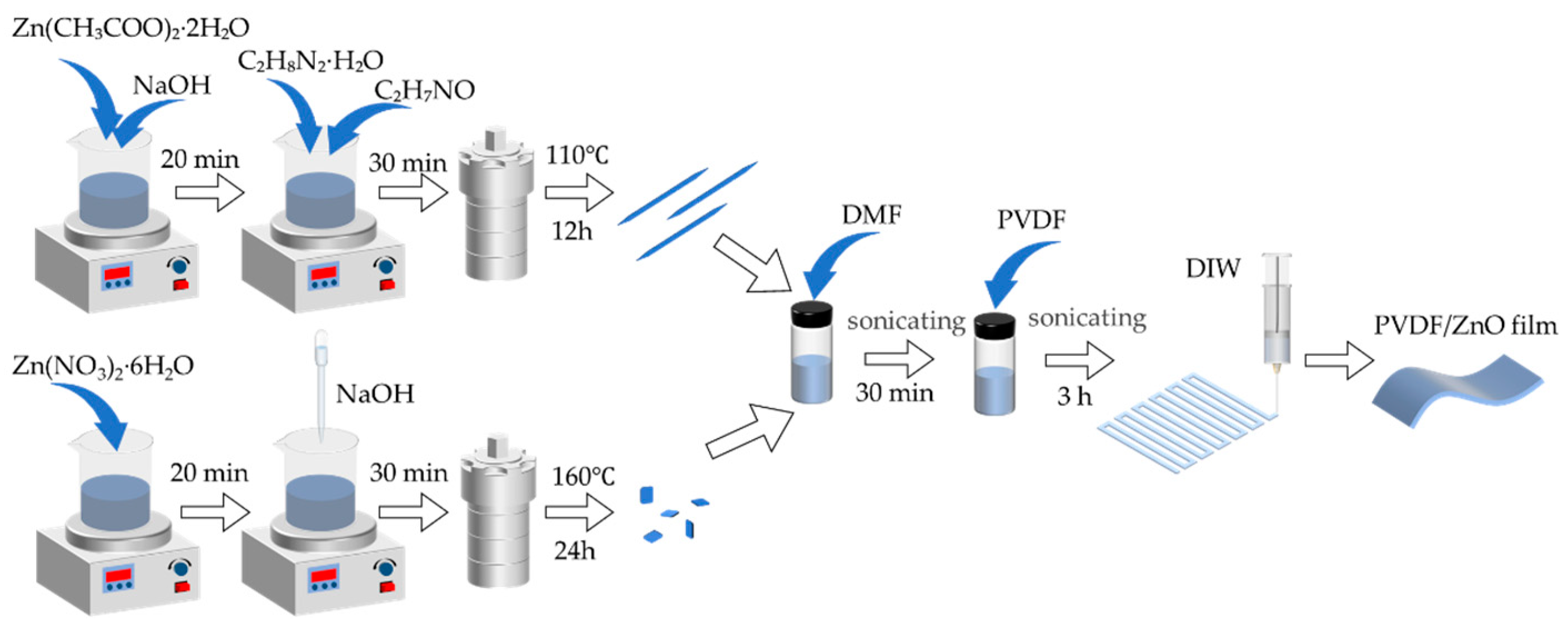
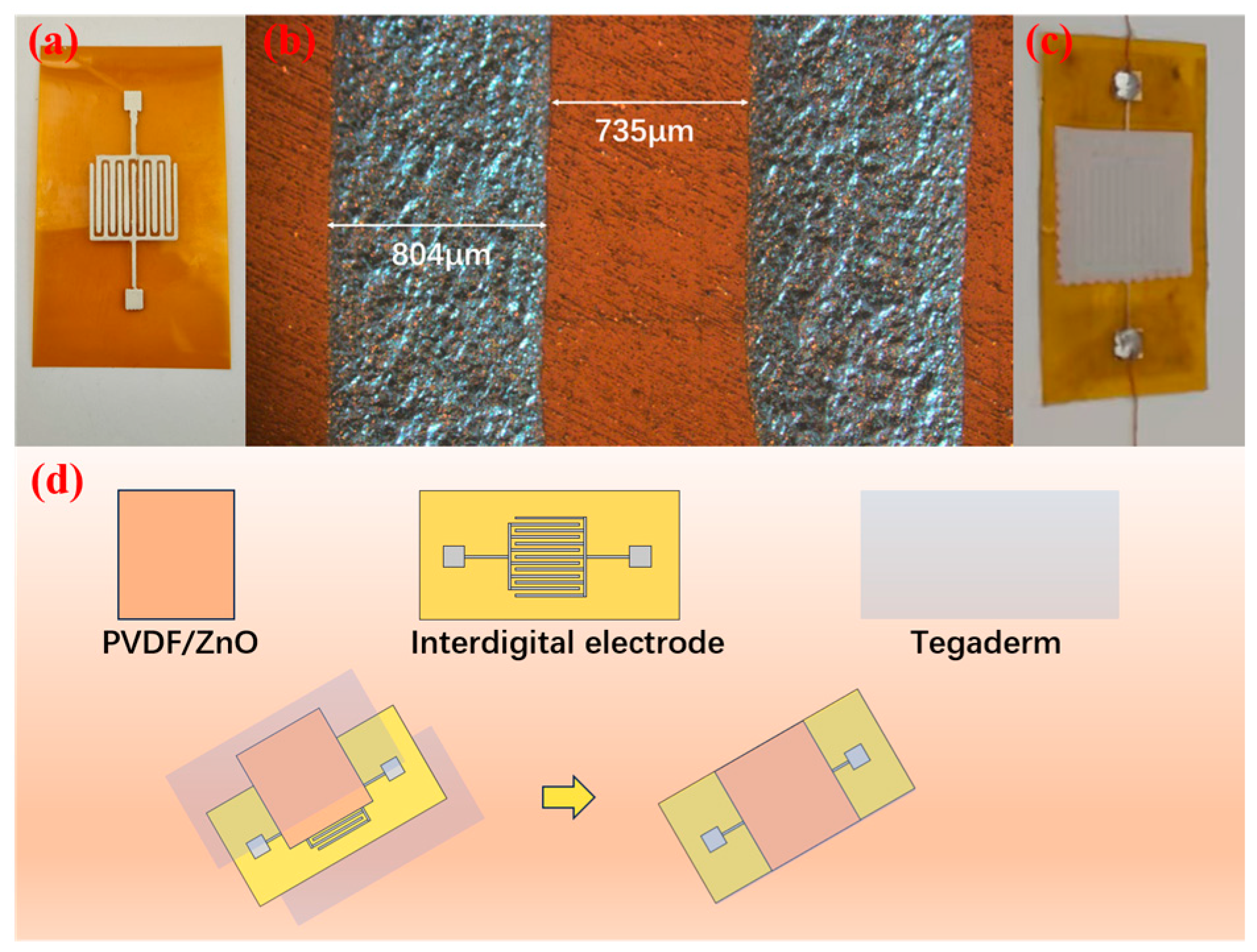
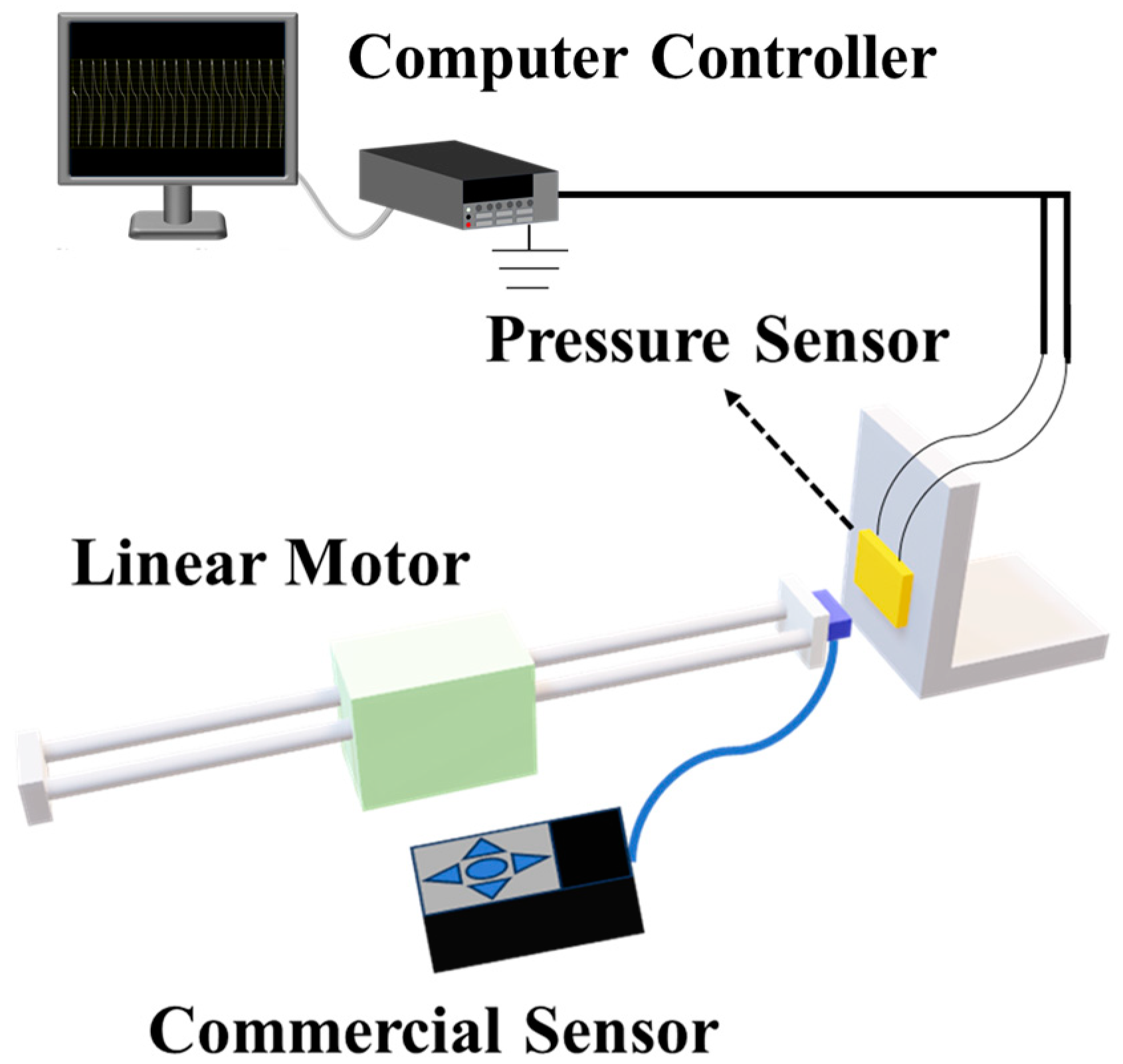




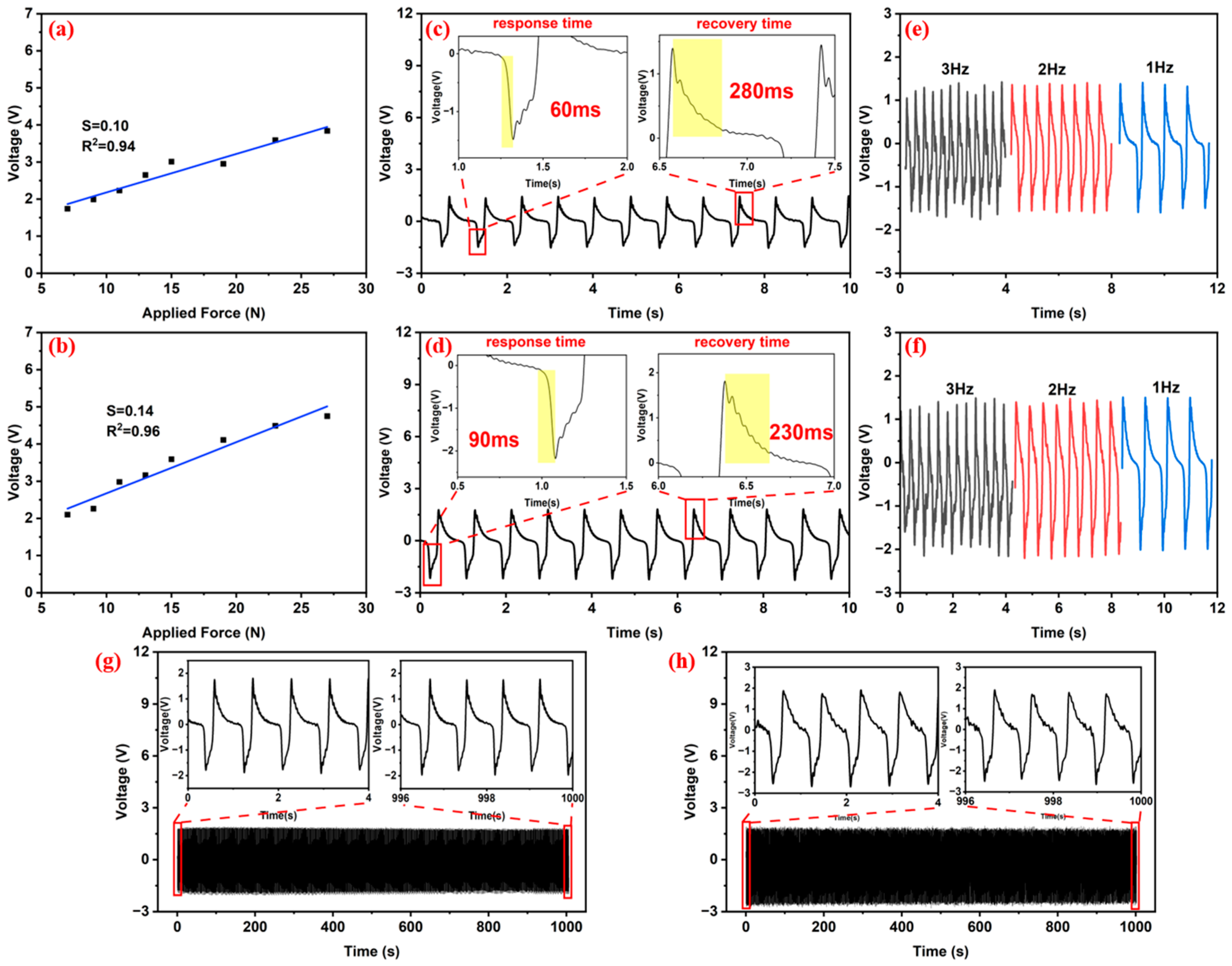
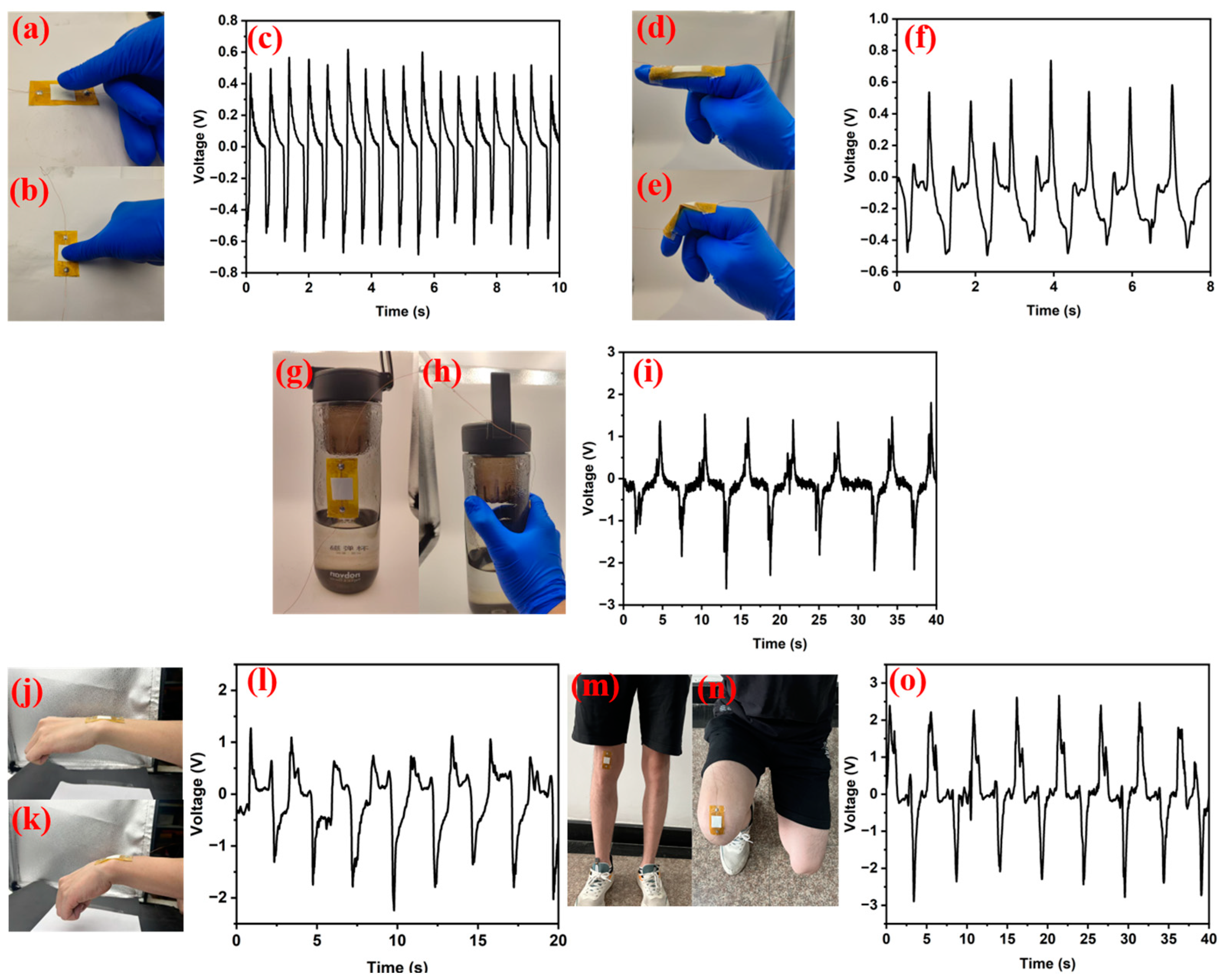
Disclaimer/Publisher’s Note: The statements, opinions and data contained in all publications are solely those of the individual author(s) and contributor(s) and not of MDPI and/or the editor(s). MDPI and/or the editor(s) disclaim responsibility for any injury to people or property resulting from any ideas, methods, instructions or products referred to in the content. |
© 2025 by the authors. Licensee MDPI, Basel, Switzerland. This article is an open access article distributed under the terms and conditions of the Creative Commons Attribution (CC BY) license (https://creativecommons.org/licenses/by/4.0/).
Share and Cite
Zhang, B.; Zhang, W.; Luo, W.; Liang, Z.; Hong, Y.; Li, J.; Zhou, G.; He, W. Morphology-Dependent Behavior of PVDF/ZnO Composites: Their Fabrication and Application in Pressure Sensors. Sensors 2025, 25, 2936. https://doi.org/10.3390/s25092936
Zhang B, Zhang W, Luo W, Liang Z, Hong Y, Li J, Zhou G, He W. Morphology-Dependent Behavior of PVDF/ZnO Composites: Their Fabrication and Application in Pressure Sensors. Sensors. 2025; 25(9):2936. https://doi.org/10.3390/s25092936
Chicago/Turabian StyleZhang, Binbin, Wenhui Zhang, Wei Luo, Zhijie Liang, Yan Hong, Jianhui Li, Guoyun Zhou, and Wei He. 2025. "Morphology-Dependent Behavior of PVDF/ZnO Composites: Their Fabrication and Application in Pressure Sensors" Sensors 25, no. 9: 2936. https://doi.org/10.3390/s25092936
APA StyleZhang, B., Zhang, W., Luo, W., Liang, Z., Hong, Y., Li, J., Zhou, G., & He, W. (2025). Morphology-Dependent Behavior of PVDF/ZnO Composites: Their Fabrication and Application in Pressure Sensors. Sensors, 25(9), 2936. https://doi.org/10.3390/s25092936







